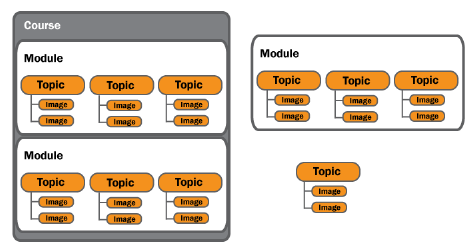
Online Learning Object Repositories (LORs) make learning resources more accessible through the creation and availability of shared information resources.
Desire2Learn Learning Repository is an online library of learning objects and associated files. An LOR is a combination of topics, modules, and assets that have been tagged with specific metadata to make them accessible to multiple users.
A learning object repository (LOR) is a general term for an online collection of learning objects. A learning object is an object or collection of objects that assists in the learning process (e.g., a topic, a module, a course, etc).
A course is a collection of modules, and a module is a collection of modules and topics. Topics have no children and cannot be descendants of a course. Topics are simple file associations (e.g., a PowerPoint file, an HTML file, a multimedia file, a URL, etc).

Examples of Learning Objects
A learning asset is an individual file with no associations. It is not considered a learning object, but must be handled by the LOR (e.g., a GIF file included in an HTML topic). Within the LOR a topic can contain an asset, but modules and courses cannot.

Examples of Learning Assets
Click the LOR link on the navigation bar, or use the LOR widget on My Home or a Course Home if it is available.
Learning Repository connects to Learning Environment through the following:
Asset An individual file with no associations. It is not considered a learning object, but must be handled by the learning object repository (e.g. a GIF file or a WAV file that is included in an HTML topic).
Complex Learning Object A learning object that can have sub-objects (i.e., a module, or a course).
Course A collection of modules.
Harvesting Metadata Retrieving metadata from learning objects in another repository.
Learning Object Repository (LOR) A library of stand-alone learning objects (LOs) from which users access LOs (i.e. modules, topics, or courses).
Learning Object (LO) A resource or collection of objects that assists in the learning process (e.g. a file, a topic, a course, etc.).
Metadata A definition or description of data, or “data about data.” Learning Repository only accepts metadata tags created using the IEEE LOM MAP (Metadata Application Profile). All searches use the IEEE LOM metadata fields.
Module A collection of topics and/or other modules.
OAI-PMH (Open Access Initiative Protocol for Metadata Harvesting) This is an industry standard protocol to implement a harvesting solution.
Org unit A department, semester, course offering, or other item within Learning Environment’s organizational structure.
Permissions Settings that control the functionality users can access in Learning Repository, as assigned in Roles and Permissions. Not the same as trust permissions (described below).
Roles An assigned role as defined by a user’s enrollments. A user’s role defines their permissions.
Topics Simple file associations (e.g. a PowerPoint file, a HTML file, a multimedia file, a URL, etc.). Topics have no children of their own and cannot be children of a course. A topic can contain an asset, but modules or courses cannot.
Trust The relationship between an LOR and an org unit. A trust contains three elements: an LOR, an org unit, and the trust permissions.
Trust permissions The roles and permissions assigned to each LOR trust.